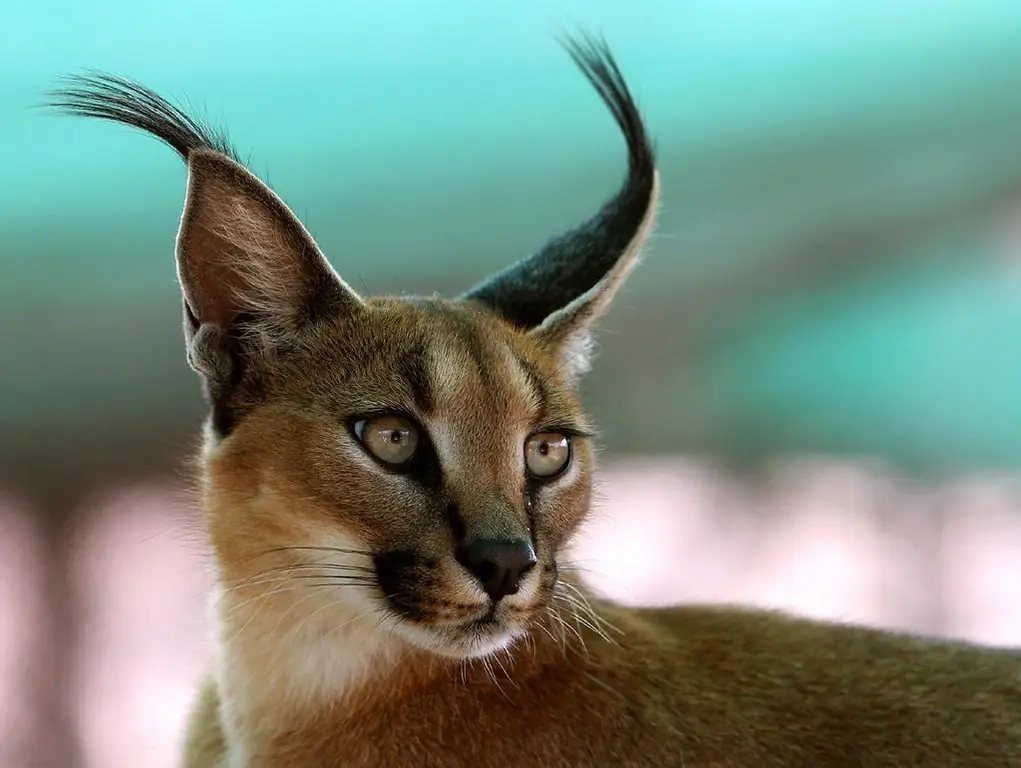
Table of contents:
- Author Bailey Albertson [email protected].
- Public 2023-12-17 12:53.
- Last modified 2025-06-01 07:32.
Caracal: a wild animal as a pet
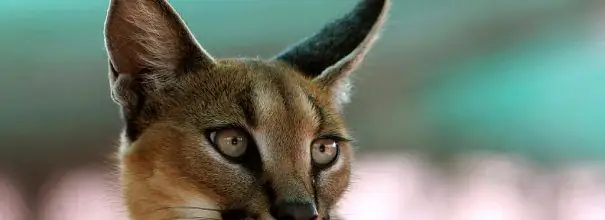
Caracals are predators of the feline family, distinguished by long black tassels on their ears. These are very capricious and demanding animals. However, with proper care and attention, desert cats will become loyal and loyal friends to their owners.
Content
- 1 Why was the caracal named so
-
2 Where does the caracal live
2.1 Video: caracal
-
3 Steppe lynx lifestyle
3.1 Video: caracal hunting
-
4 How to keep a home caracal
4.1 Video: caracal at home
- 5 Caring for the health of the steppe lynx at home
- 6 Habits of a domestic caracal
- 7 Buying a caracal: highlights
- 8 Reviews on the purchase of caracals
Why was the caracal named so
Fast and hardy animals, caracals stand out for their unusual appearance due to the long dark tufts of hair on the ears. The literal translation of the name of these representatives of the feline family from Turkish means "black ears". Outwardly, caracals are similar to the common lynx. Common features of these animals are wide paws and round pupils. But, unlike the lynx, the steppe cat has a long tail.
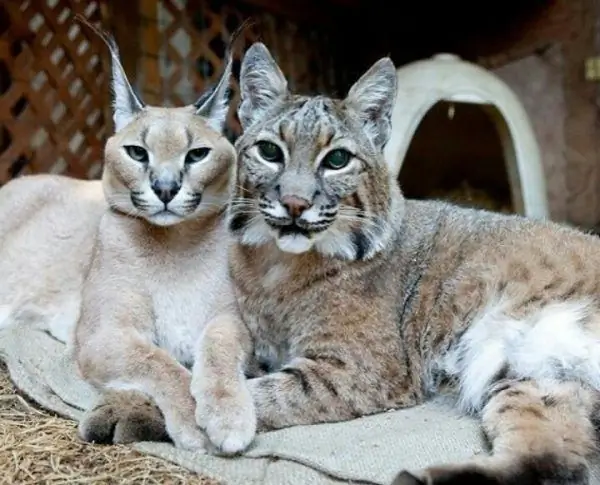
Caracal - the closest relative of the common lynx
Other characteristic features of the appearance of a caracal are:
- slender body weighing no more than 20-24 kg;
- compact size of the body - the height at the withers is on average 40 cm, and the body length reaches a maximum of 100 cm;
- long tail - in adults, the size of this part of the body varies from 24 to 31 cm;
- short coat with a dense undercoat, moderately hard to the touch;
- a small graceful head with an elongated muzzle, on which blotches of black hair are noticeable on the sides and near the eye sockets;
- elongated paws, able to overcome sand dunes due to the stiff bristles on the outside of the brushes;
- a short mustache next to a large black nose, the latter being distinguished by pinkish pigment in the central part;
- high (up to 4-5 cm) pointed ears with long black sickle-shaped tassels;
- monochromatic color with a predominance of sandy shades (from light beige to reddish), alternating with white (on the belly, throat, chin and inside the ears) and black (outer part of the ears) wool.
Otherwise, the caracals are called desert or steppe lynxes. This is due to the distribution area of the animal - the desert shores of the Caspian and Red Seas, the steppes of Turkmenistan and Dagestan, the plateaus of Turkey and Iran.
To this day, African caracals do not need protection, which cannot be said about their Asian counterparts. The latter are reducing their numbers every year, which is why they were included in the Red Book.
Where does the caracal live
Despite the telling name, these cats can be found not only among the sand dunes and steppe feather grass. Caracals live both in forests and in foothill regions. The flexible body and elastic legs allow the steppe lynx to climb trees dexterously. From there, a wide view of the conquered territories opens. By the way, the area of those can reach 340 km 2 and more.
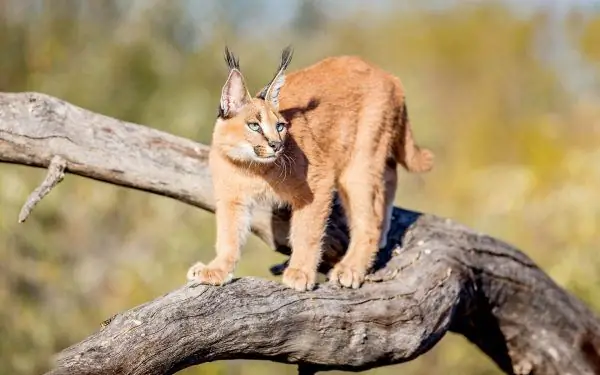
Caracals, like other cats, deftly climb trees
For rest, the caracal prefers to look for holes or crevices in the rocks abandoned by other animals. If the animal likes the place, the desert lynx will return to such a shelter for many years.
By their nature, these animals are loners. Having reached puberty by the first year of life, the caracal leaves its fellows to conquer its own territory.
Video: caracal
Steppe lynx lifestyle
The life of a wild caracal kitten begins after 75-80 days of the female's pregnancy. In a litter, as a rule, there are no more than three cubs. The brood is born blind, and only two weeks later the kittens begin to see. Until this moment, the female jealously guards the offspring hidden in a gorge or an abandoned hollow of a fallen tree.

Females of the steppe lynx are caring and zealous mothers
The color of caracal cubs differs from the appearance of adults by a large number of dark specks on the coat. Over time, only the muzzle remains spotty.
A month after birth, kittens begin to explore the territory near the den, and after another month the female transfers the babies to solid food.
Regarding the latter, the following should be noted:
- caracals feed mainly on small rodents and birds like guinea fowls;
- steppe lynxes get food at night;
- these animals hunt, reaching their prey with the help of large jumps (up to 5 meters in length) or waiting at watering places;
- make such cats and caches with food high in the trees.
Since the animal is accustomed to life in arid regions, the caracal can go without drinking for a long time - up to ten days this cat is able to get liquid only from food. In this case, the diet of the desert lynx is expanded by including herbs and berries (for example, grapes) in the menu.
Caracals are dexterous and clever predators, skillfully camouflaging among thickets of bushes. So these animals have few enemies. The main threat is posed by birds of prey during the rearing period. And for adults, lions and hyenas become enemies if the animal lives in the African savannas, or steppe wolves and alabai guarding sheep (when it comes to Kazakh or Turkmen steppe lynxes).
However, locals often hunt by poaching against steppe lynxes because of the threat of a reduction in the livestock population.
Video: caracal hunting
How to keep a home caracal
Before acquiring such an exotic pet, you need to take care of creating acceptable living conditions for a caracal in a country house or city apartment.
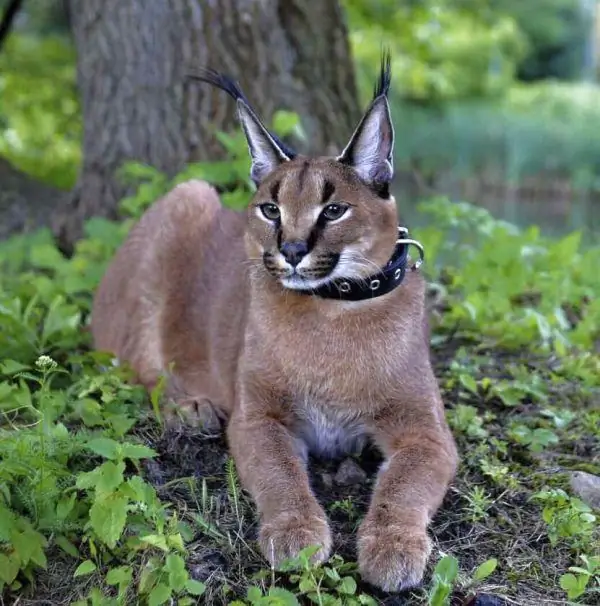
Caracals have been tamed by people since time immemorial
First you need to allocate a place for the wild cat to live. The aviary should be spacious - at least 20 m 2. A scratching post and other accessories necessary for the animal's games - logs, steps, shelves, are necessarily installed inside. If the owner of the caracal lives in an apartment, you need to take care of the regular and long walking of the animal. After all, desert lynxes are very mobile cats that need to run and jump.
Caring for a caracal requires compliance with a number of rules:
- you need to wash your pet as rarely as possible so as not to damage the skin and coat;
- the ears and eyes should be checked regularly for contamination;
- you need to comb the animal's fur at least once every seven days;
- It is recommended to remove claws on the front paws using laser technology, and it is better to carry out the procedure even in the nursery before purchasing.
To maintain the health of such an exotic pet at the proper level, it is important to properly organize the food of the caracal.
A balanced menu for a home desert lynx should include:
- meat dishes - poultry, rabbits, beef;
- fish dishes, including fillets of sea fish at least once every five to seven days;
- raw chicken eggs no more than once every seven days;
- seasonal fresh grass or dry food in winter.
You can not feed the caracal with pork and salty food, sausage and confectionery products are prohibited.
In order to maintain the normal state of the intestinal microflora, it is necessary to add food familiar to predators once a week to the diet of the steppe lynx - small rodents, uncut carcasses of birds.
The feeding regimen involves two meals a day. And for males it is recommended to arrange a "fasting day" every two weeks. At this time, the animal must starve, having access only to water resources. Such a need is due to the fact that in their natural habitat, animals forage irregularly, thereby avoiding obesity and other health problems.
The daily portion for an adult caracal is from 350 to 600 g of meat, depending on the age and weight of the pet
It is also interesting that it is better to give food to the steppe lynx every day at different times, so that there is no getting used to the feeding schedule.
Video: caracal at home
Taking care of the health of the steppe lynx at home
Home caracals are distinguished by their unpretentious care and excellent immunity. Animals rarely get sick with proper care of the owners.
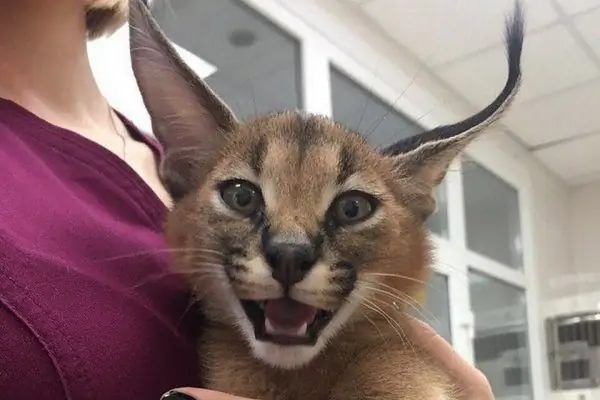
Regular examination by a veterinarian is a guarantee of the health and longevity of a domestic caracal
The main health problem can be Auesky's disease, characterized by the appearance of itchy lesions on the skin of the animal and the disorder of the nerve endings. Such an ailment is possible in case of irregularities in the diet, when the animal is fed pork.
If the owner carefully observes the requirements for the maintenance and care of the steppe lynx, regularly vaccinates and visits the veterinarian with the pet, then such a wild cat will not be in trouble with the well-being.
The first vaccination for caracal is given at the age of 3 months, followed by revaccination, after 30 days. And also pets are vaccinated against rabies. Among the vaccines for the steppe lynx living with humans are panleukemia, rhinotracheitis and calcevirosis.
Routine visits to the veterinary clinic should be twice a year.
Caracals are considered centenarians among other representatives of the feline family. The average life span of an animal is at least 12-14 years.
Domestic caracal habits
The owners love steppe lynxes for their playful character and calm disposition. These animals lend themselves well to training, easily come to an understanding with all family members and other pets.
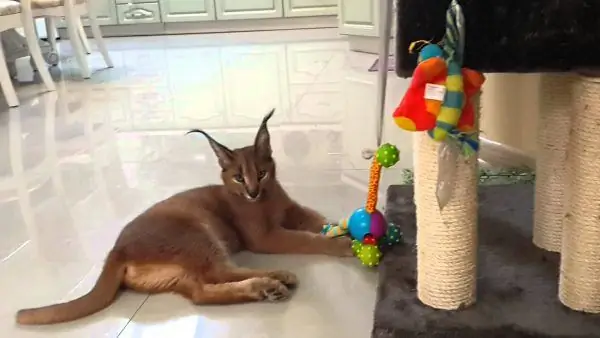
Caracals are very playful and agile pets
If you do not create unbearable conditions for the animal in the form of a limited space and a bad attitude (these predators cannot stand high tones in conversation and physical impact), then the desert lynx will become a devoted and affectionate friend.
Since the animal has irrepressible energy, in the absence of a proper approach to education, it can regularly play naughty and plunge the living room into chaos. To cope with a wild animal at home without much effort, you need to accustom the cat to the correct manners from an early age:
- make demands as clearly and consistently as possible;
- establish acceptable behavioral standards and restrictions.
Behavior problems can be expected by owners of domestic steppe lynxes with young pets. After reaching the age of two, caracals become more docile and more balanced.
In addition, in order to avoid manifestations of aggression and leaving specific marks on household items, it is better to castrate the male (up to 5 months) and sterilize the female (at 9 months) before puberty.
By their nature, caracals resemble dogs, because these animals also love to run and play with a ball. Steppe lynxes are also well trained to leash.
As toys for an exotic cat, it is better to choose accessories for dogs or children's toys. After all, such items, intended for ordinary cats, are not suitable for caracals due to their small size.
Buying a caracal: highlights
Caracals are an expensive treat for exotic lovers. After all, one kitten of the steppe lynx is estimated at no less than 400 thousand rubles. The cost depends on several factors - this is the purpose of the purchase (kittens for breeding are more expensive), and the sex of the animal (seals are cheaper than kittens). Affects the price tag and the breeding area of the desert lynx.
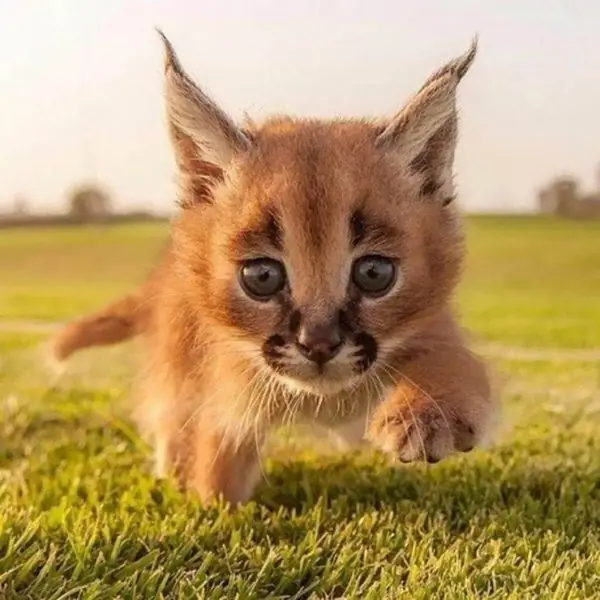
It is better to acquire a caracal kitten before six months of age, so that the animal will immediately adapt to a new place and family
It is better to choose an animal in proven nurseries and do not seek help from dubious "suppliers" without the necessary documentation. In addition to the fact that the desert lynx may turn out to be sick and socially unadapted, such an animal is subject to seizure due to violation of the legislation on the procedure for processing documentation for this type of mammal.
In order for the pet to be kind and not show aggression, it is recommended to take the steppe lynx in a home breeding nursery, and not an aviary type. The best age to buy a caracal is considered to be 6 months from the date of birth.
Another factor that helps to get a kind and docile caracal into your pet will be the choice of the animal's parents. When a kitten is taken from a couple who grew up in a cattery, the animal will further delight with a playful and inquisitive character. In the case of acquiring a wild baby, you can get an animal poorly adapted for life among people. Since in their natural environment, caracals are uncommunicative and prefer solitude to a noisy company, jealously guarding the captured territory. There are known cases of attacks of steppe lynxes on predators and dogs, twice the size of these cats.
Before you make a choice in favor of a certain kitten, you need to carefully study the behavior of the animal, follow the attitude of the little caracal to others. It is necessary to pay attention to the appearance of the steppe lynx - the cleanliness of the ears and eyes, the healthy appearance of the coat (the coat should shine and be easy to iron).
The main document issued when buying a caracal is the animal's veterinary passport. This paper marks the vaccinations given to the desert lynx at the state veterinary clinic.
Reviews on the purchase of caracals
Despite certain difficulties in buying and maintaining a steppe lynx, such a pet becomes a frequent resident of country houses of wealthy citizens.
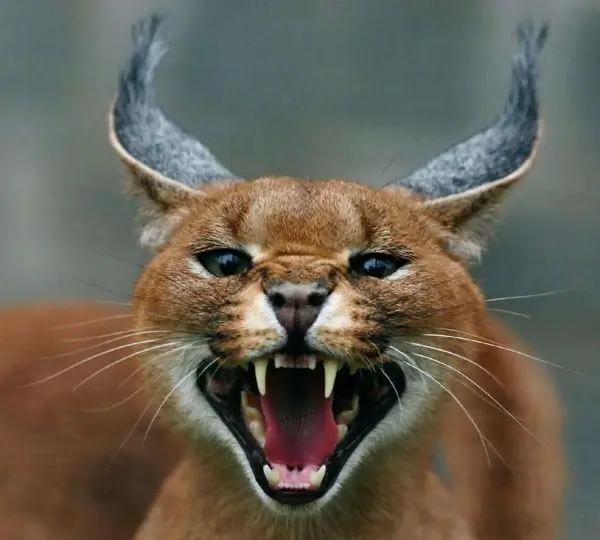
Caracals - predators, which are safely turned on by lovers of exotic
In my opinion, no matter how tame the caracal may become, this cat still remains a wild beast. Predatory genes can show up in unexpected ways. Which is dangerous not only for torn and broken furniture, but also for injury to family members. Especially alarming is the establishment of such an exotic pet in the houses where children live.
Among pet lovers, opinions on the acquisition of a caracal for private ownership also differ:
Caracal is a graceful and graceful feline. For its beautiful appearance and docile nature, this animal has attracted the owners of exotic cats from ancient times. However, in order to keep the desert lynx at home, you must strictly follow the mandatory requirements for this type of animal. And then the playful pet will delight the owner and his family for many years.
Recommended:
Savannah: Description Of The Cat Breed, Features Of Care And Maintenance, Photos, Reviews Of Cat Owners
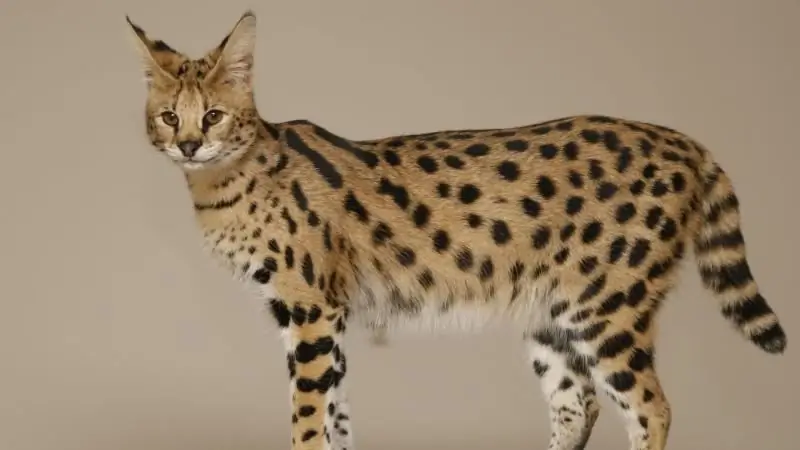
History and origin of the Savannah breed. Differences from other breeds. Features of character, upbringing and care. Choosing a kitten. Breeding animals. Reviews of the breed
Serial: Description Of The Breed, Character Of The Serval, Maintenance And Care At Home, Photo Of The Cat

Description, habitat and habits of a bush cat, features of keeping in captivity, hybrids of a serval and a domestic cat
Anatolian Cat: Features Of The Breed's Appearance, Care And Maintenance Of The Cat, Character And Habits, Breeding Pets, Owner Reviews

Where the Anatolian breed is bred. The main external differences, the nature of the pet. How to properly care for him, feed him. How to choose a kitten. Breeding. Reviews
Norwegian Forest Cat: History Of The Breed, Characteristics, Photos, Care And Maintenance At Home, Reviews Of Cat Owners
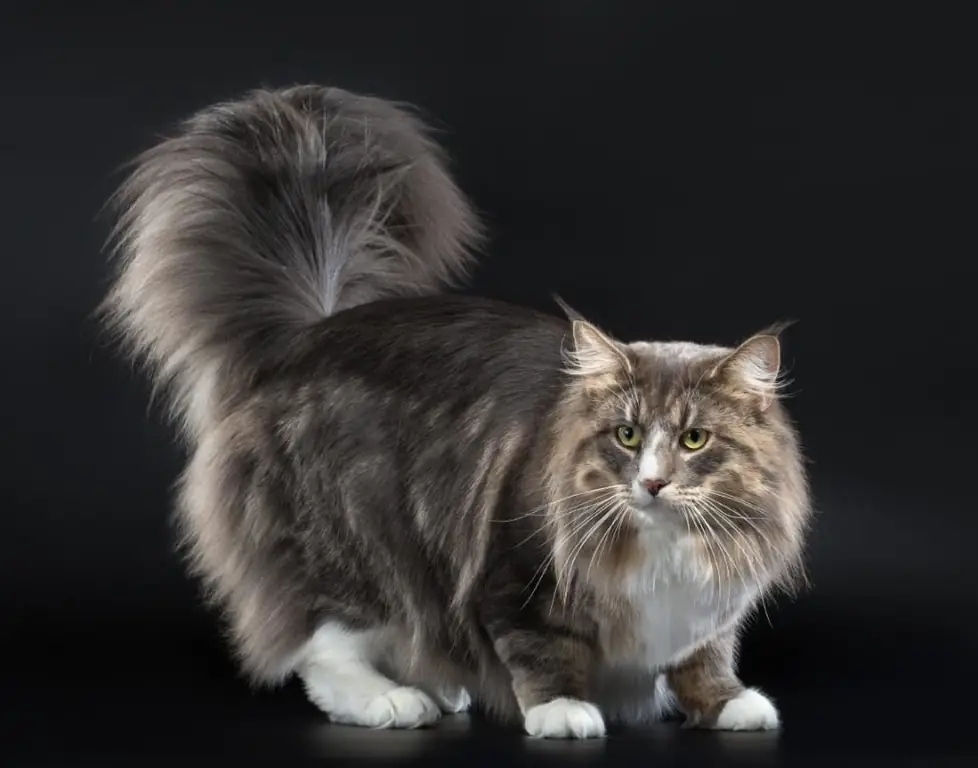
Distinctive features of the Norwegian Forest Cat. The main characteristics of the breed. Home maintenance, care and hygiene. The nuances of choosing a kitten. Reviews. Photo
Manx (Manx Cat): Description Of The Breed, Character, Tips For Maintenance And Care, Photo
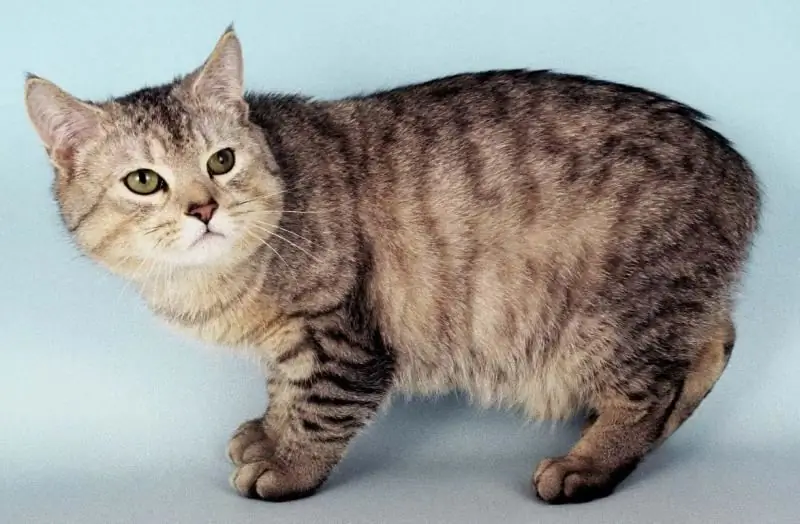
The origin of the manks, their appearance and character. Specific diseases. Features of care and breeding. Kitten selection rules
